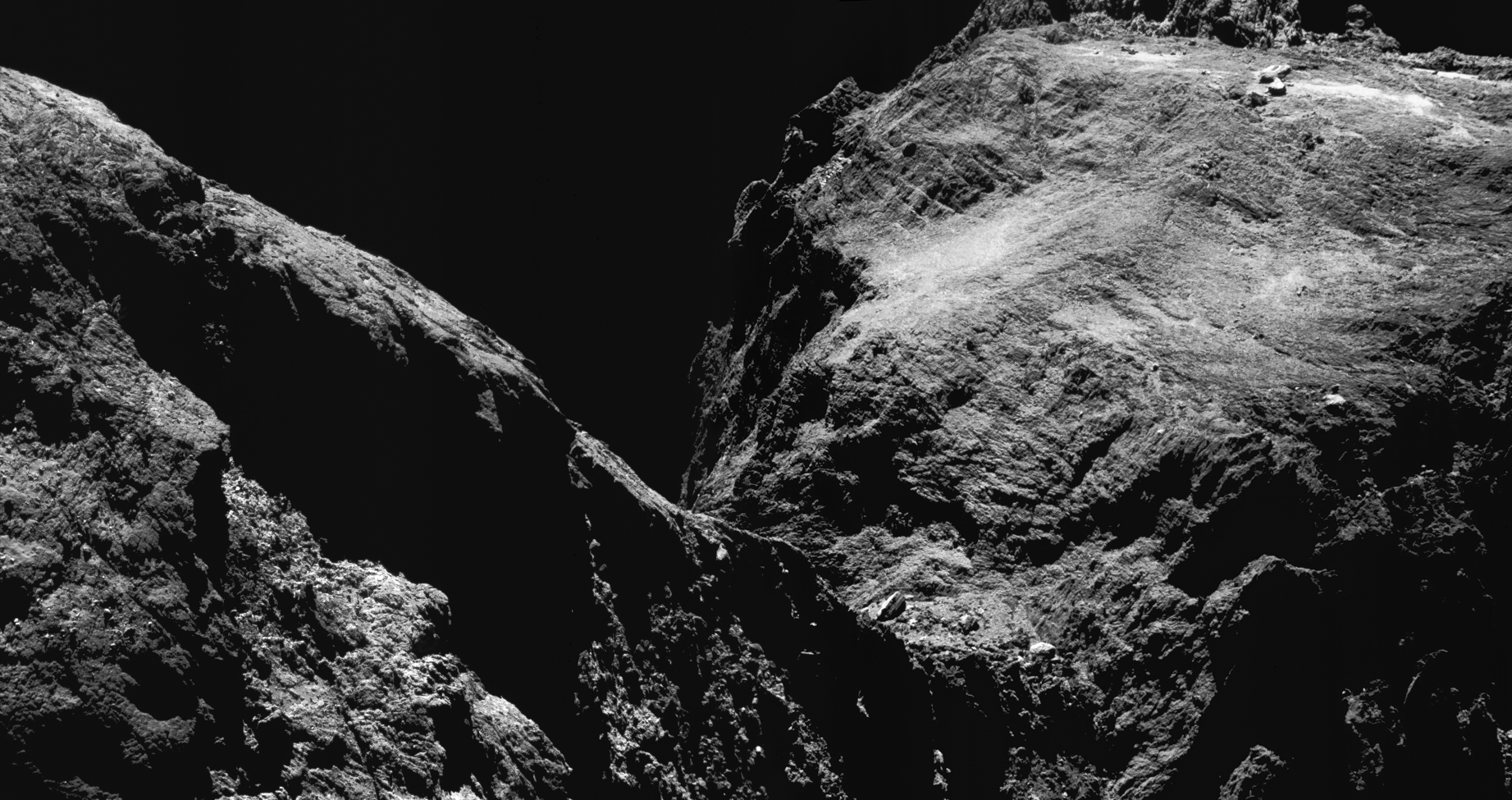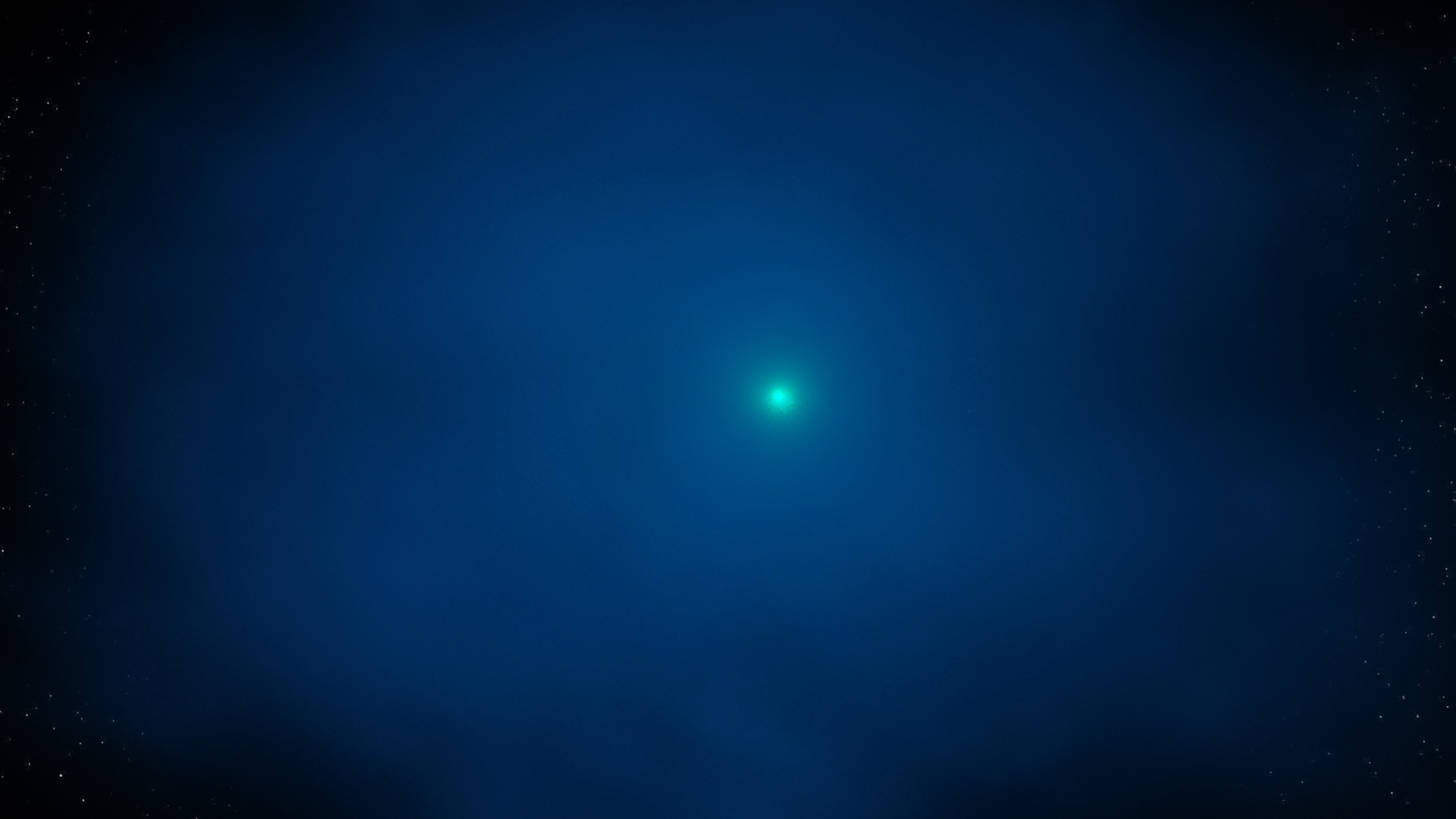Relation between comets and earth’s atmosphere uncovered
The difficult yet successful measurement of several isotopes of the noble gas xenon on comet 67P/Churyumov-Gerasimenko using the Bernese instrument ROSINA on the Rosetta probe shows that materials arrived on Earth due to comet impacts. As proven by further Bern measurements of silicon isotopes, in the beginning our solar system was extremely heterogeneous. The high amount of so-called "heavy" water also shows that cometary ice is older than our solar system.
Xenon is a colourless, odourless gas that makes up far less than one millionth of the volume of the entire earth’s atmosphere. As a noble gas, it rarely reacts with other elements and thus has a relatively stable atomic state. It is therefore a relatively accurate representation of the conditions that existed during the formation of our solar system. Xenon can also help to answer the age-old question about comets: does material on Earth come from comet impacts and if so, to what extent?
A research team led by Kathrin Altwegg at the Center for Space and Habitability (CSH) of the University of Bern was able to show that the xenon composition on the comet 67P/Churyumov-Gerasimenko is very similar to the "indigenous xenon" first posited 40 years ago, which arrived on our planet from beyond shortly after the formation of our solar system. These measurements, which will now be published in "Science", show that around one fifth of indigenous xenon originates from comets. This means that for the first time ever we can draw a quantitative link between comets and the earth’s atmosphere.
Stellar fingerprint
Xenon is formed in many different stellar processes, including supernova explosions. Each of these phenomena leads to a typical distribution of xenon isotopes, a specific "fingerprint". Due to its many isotopes from various stellar processes, xenon gives an important indication of indigenous materials that make up our solar system. Xenon isotopes were measured in Earth’s and Mars’ atmospheres, in meteorites originating from asteroids, on Jupiter and in solar wind – the flow of charged particles from the sun. The composition of xenon in the earth’s atmosphere has more heavy than light isotopes, as light isotopes can escape the earth’s gravitational field into space. By correcting this effect, researchers in the 1970s calculated the original composition of this noble gas, the so-called indigenous xenon that once dominated the earth’s atmosphere. This indigenous xenon contains far fewer heavy isotopes and the composition of the light isotopes is equal to that of xenon coming from asteroids and the sun. It was therefore believed that indigenous xenon in the earth’s early atmosphere had a different origin compared to the at the time observed objects in the solar system. This is now confirmed by ROSINA measurements on the Rosetta probe at comet 67P/Churyumov-Gerasimenko, an icy "fossil" from the early solar system.
Difficult mission
"The search for xenon on comets was probably one of the most important and most difficult measurements by ROSINA", says Kathrin Altwegg, ROSINA project leader at the Center for Space and Habitability (CSH) of the University of Bern. "The fact that we have solved a part of a 40-year old mystery in doing so makes it all the more rewarding". Xenon is extremely rare in the already thin atmosphere of the comet. The Rosetta probe thus had to fly really close to the comet for weeks – 7 to 10 km from the centre – so that ROSINA could pick up sufficient signal for a clear measurement of the seven most common isotopes. The risk with this was that the dense cloud of dust surrounding the comet could have tripped the probe’s navigation system. ROSINA managed to identify seven xenon isotopes as well as various other noble gases. Analysis of the data showed that the cometary xenon that was frozen during the formation of the comet differs from the composition found in the solar system as well as from the composition found today in the earth’s atmosphere. The composition of the cometary xenon is most likely equal to that of the posited indigenous xenon in Earth’s early atmosphere. However, there are certain differences between both compositions which leads researchers to believe that the original xenon comes partly from comets and partly from asteroids: "For the first time we were able to establish a quantitative link between comets and our earth’s atmosphere – according to which 22 percent of the earth’s original, atmospheric xenon originates from comets, whilst the rest comes from asteroids" summarises Altwegg.
No contradiction to water
These findings do not contradict ROSINA’s isotope measurement in the water on the comet which was significantly different to that of indigenous water. As xenon is only available in traces in the atmosphere whilst Earth contains vast quantities of water in the oceans and atmosphere, comets could have definitely contributed to the xenon found on Earth without changing the indigenous water too much. "The xenon findings also support the idea that organic material came to Earth through comets – such as phosphorous and the amino acid glycine which were both found on the comet by ROSINA – which was potentially crucial for the evolution of life on Earth" says Altwegg. Ultimately, the difference between the cometary xenon and the xenon found in the solar system indicates that the so-called protosolar nebula that lead to the formation of the sun, planets and small bodies, was a chemically rather heterogeneous place. "This supports earlier measurements by ROSINA such as the unexpected discovery of molecular oxygen (O2) or molecular sulphur (S2)" says Altwegg.
Second publication confirms findings
In another publication, a research group led by Martin Rubin (CSH) was able to show that silicon on the comet does not show the average isotope ratio of our solar system. The ROSINA data thus shows that material from the early solar system originates from various predecessor stars. As with xenon, this means that the chemical composition of the early solar system was heterogeneous, thus not "uniformly" mixed as previously believed. The second publication appears in "Astronomy and Astrophysics". ROSINA had already discovered silicon atoms in the gas envelope of the comet early in the mission. These silicon atoms were sputtered off of the surface of the comet by the impacting solar wind. A precise analysis by Martin Rubin from the CSH has now shown that silicon isotopes also exhibit an anomaly when compared with solar silicon. The heavy silicon isotopes are less common in comparison to the mix found near the sun and meteorites. This suggests that comets are formed in an area of the protosolar nebula that shows a non-solar chemical composition – and thus has potentially taken on material from another star or supernova in the vicinity.
Even cometary water comes from beyond
A third publication also published recently proves definitively with the use of hydrogen isotopes that cometary water – so-called "heavy" water (D2O) – was formed before the formation of the solar system and was frozen as pre-solar ice in comets. These findings were published in a special edition of "Philosophical Transaction of the Royal Society, London".
"Our findings in all three studies have fulfilled the main aim of the Rosetta mission, namely to find quantitative indication of the formation of the earth and our solar system for the first time" says Altwegg.
Details about the publications:Marty, B., Altwegg, K., Balsiger, H., Bar-Nun, A., Bekaert, D., Berthelier, J.-J., Bieler, A., Briois, C., Calmonte, U., Combi, M., De Keyser, J., Fiethe, B., Fuselier, S. A., Gasc, S., Gombosi, T. I., Hansen, K. C., Hässig, M., Jäckel, A., Kopp, E., Korth, A., Le Roy, L., Mall, U., Mousis, O., Owen, T., Rème, H., Rubin, M., Sémon, T., Tzou, C.-Y., Waite, J. H., and Wurz, P.: Xenon isotopes in Comet 67P/Churyumov-Gerasimenko show comets contributed to Earth's atmosphere, Science, in press. Rubin, M., Altwegg, K., Balsiger, H., Berthelier, J.-J., Bieler, A., Calmonte, U., Combi, M., De Keyser, J., Engrand, C., Fiethe, B., Fuselier, S. A., Gasc, S., Gombosi, T. I., Hansen, K. C., Hässig, M., Le Roy, L., Mezger, K., Tzou, C.-Y., Wampfler, S. F., and Wurz, P.: Depletion of the heavy silicon isotopes measured at comet 67P/Churyumov-Gerasimenko, Astron. Astrophys., 17 May 2017, doi: 10.1051/0004-6361/201730584. Altwegg, K., Balsiger, H., Berthelier, J.-J., Bieler, A., Calmonte, U., De Keyser, J., Fiethe, B., Fuselier, S. A., Gasc, S., Gombosi, T. I., Owen, T., Le Roy, L., Rubin, M., Sémon, T., and Tzou, C.-Y.: D2O and HDS in the coma of 67P/Churyumov-Gerasimenko, Phil. Trans. R. Soc. A, [Cometary science after Rosetta, Editors: Geraint Jones, Matthew Knight, Alan Fitzsimmons and Matt Taylor, Online, May 2017], in press. |
2017/06/08



